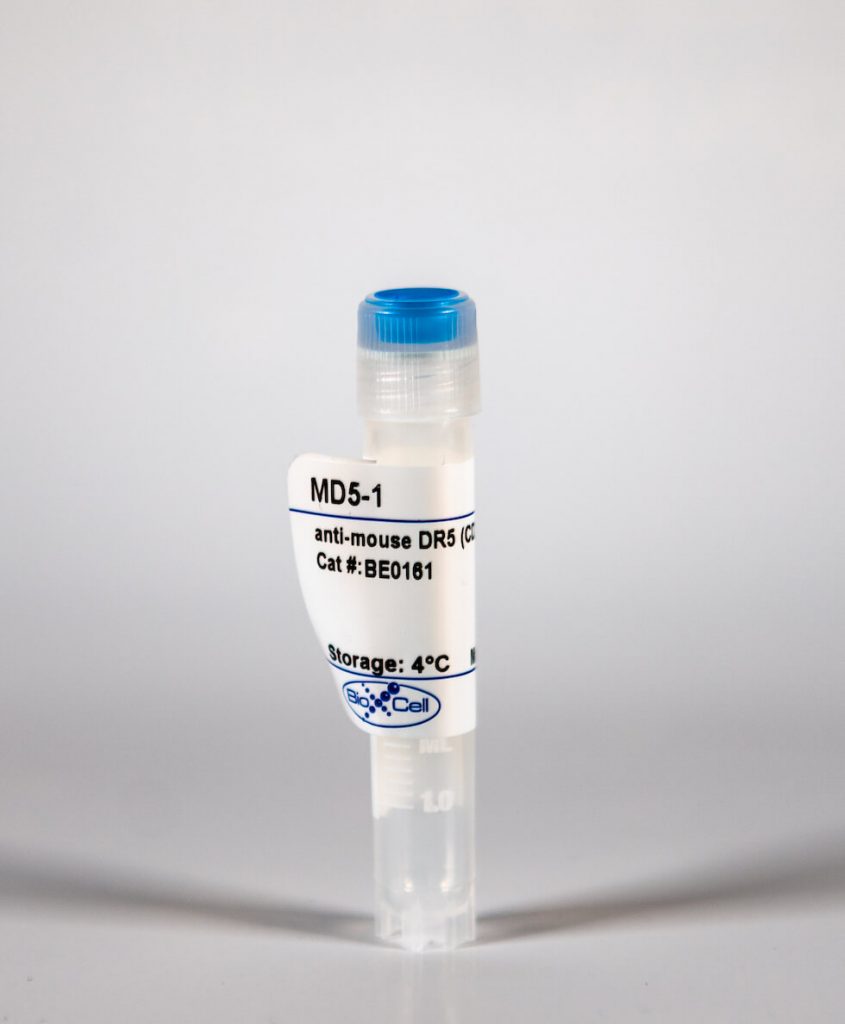InVivoMAb anti-mouse DR5 (CD262)
| Clone | MD5-1 | ||||||||||||
|---|---|---|---|---|---|---|---|---|---|---|---|---|---|
| Catalog # | BE0161 | ||||||||||||
| Category | InVivoMab Antibodies | ||||||||||||
| Price |
|
The MD5-1 monoclonal antibody reacts with mouse death receptor 5 (DR5) also known as CD262 and TRAIL-R2. DR5 is a 55 kDa member of the TNF receptor superfamily and is expressed by most cell types. Upon binding to its ligand TRAIL, DR5 activates NF-κB and induces TRAIL-mediated apoptosis. The MD5-1 antibody has been shown to induce TRAIL-mediated apoptosis in vitro and in vivo.
| Isotype | Armenian Hamster IgG, κ |
| Recommended Isotype Control(s) | InVivoMAb polyclonal Armenian hamster IgG |
| Recommended Dilution Buffer | InVivoPure™ pH 7.0 Dilution Buffer |
| Immunogen | Mouse DR5-Ig fusion protein |
| Reported Applications |
|
| Formulation |
|
| Endotoxin |
|
| Purity |
|
| Sterility | 0.2 μM filtered |
| Production | Purified from tissue culture supernatant in an animal free facility |
| Purification | Protein G |
| RRID | AB_10950391 |
| Molecular Weight | 150 kDa |
| Storage | The antibody solution should be stored at the stock concentration at 4°C. Do not freeze. |
InVivoMAb anti-mouse DR5 (CD262) (Clone: MD5-1)
Condamine, T., et al. (2014). “ER stress regulates myeloid-derived suppressor cell fate through TRAIL-R-mediated apoptosis.” J Clin Invest 124(6): 2626-2639. PubMed
Myeloid-derived suppressor cells (MDSCs) dampen the immune response thorough inhibition of T cell activation and proliferation and often are expanded in pathological conditions. Here, we studied the fate of MDSCs in cancer. Unexpectedly, MDSCs had lower viability and a shorter half-life in tumor-bearing mice compared with neutrophils and monocytes. The reduction of MDSC viability was due to increased apoptosis, which was mediated by increased expression of TNF-related apoptosis-induced ligand receptors (TRAIL-Rs) in these cells. Targeting TRAIL-Rs in naive mice did not affect myeloid cell populations, but it dramatically reduced the presence of MDSCs and improved immune responses in tumor-bearing mice. Treatment of myeloid cells with proinflammatory cytokines did not affect TRAIL-R expression; however, induction of ER stress in myeloid cells recapitulated changes in TRAIL-R expression observed in tumor-bearing hosts. The ER stress response was detected in MDSCs isolated from cancer patients and tumor-bearing mice, but not in control neutrophils or monocytes, and blockade of ER stress abrogated tumor-associated changes in TRAIL-Rs. Together, these data indicate that MDSC pathophysiology is linked to ER stress, which shortens the lifespan of these cells in the periphery and promotes expansion in BM. Furthermore, TRAIL-Rs can be considered as potential targets for selectively inhibiting MDSCs.
Martin, B. P., et al. (2011). “Antitumor activities and on-target toxicities mediated by a TRAIL receptor agonist following cotreatment with panobinostat.” Int J Cancer 128(11): 2735-2747. PubMed
The recent development of novel targeted anticancer therapeutics such as histone deacetylase inhibitors (HDACi) and activators of the TRAIL pathway provide opportunities for the introduction of new treatment regimens in oncology. HDACi and recombinant TRAIL or agonistic anti-TRAIL receptor antibodies have been shown to induce synergistic tumor cell apoptosis and some therapeutic activity in vivo. Herein, we have used syngeneic preclinical models of human solid cancers to demonstrate that the HDACi panobinostat can sensitize tumor cells to apoptosis mediated by the anti-mouse TRAIL receptor antibody MD5-1. We demonstrate that the combination of panobinostat and MD5-1 can eradicate tumors grown subcutaneously and orthotopically in immunocompetent mice, while single agent treatment has minimal effect. However, escalation of the dose of panobinostat to enhance antitumor activity resulted in on-target MD5-1-mediated gastrointestinal toxicities that were fatal to the treated mice. Studies performed in mice with knockout of the TRAIL receptor showed that these mice could tolerate doses of the panobinostat/MD5-1 combination that were lethal in wild type mice resulting in superior tumor clearance. Given that clinical studies using HDACi and activators of the TRAIL pathway have been initiated, our preclinical data highlight the potential toxicities that could limit the use of such a treatment regimen. Our studies also demonstrate the power of using syngeneic in vivo tumor models as physiologically relevant preclinical systems to test the antitumor effects and identify potential side effects of novel anticancer regimens.






